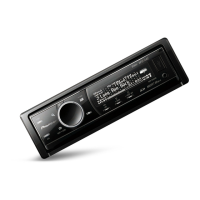What does ERROR-15 mean on Pioneer Car Receiver?
- TThomas JacksonSep 1, 2025
If your Pioneer Car Receiver displays ERROR-15, it means the inserted disc is blank. Replace the disc.

What does ERROR-15 mean on Pioneer Car Receiver?
If your Pioneer Car Receiver displays ERROR-15, it means the inserted disc is blank. Replace the disc.
What to do if my Pioneer DEH-9350SD says 'Non-compatible' with iPod?
To fix this, disconnect your iPod device and replace it with a compatible iPod.
Why does my Pioneer DEH-9350SD Car Receiver say 'SKIPPED' when playing from USB?
If your Pioneer Car Receiver displays 'SKIPPED' when using a USB storage device, the connected USB storage device contains files embedded with Windows Media DRM 9/10. Play an audio file not embedded with Windows Media DRM 9/10.
What does the 'PROTECT' error mean on my Pioneer DEH-9350SD Car Receiver with USB?
If your Pioneer Car Receiver displays 'PROTECT' when using a USB storage device, all the files may be embedded with Windows Media DRM 9/10. Transfer audio files not embedded with Windows Media DRM 9/10 to the USB storage device and connect.
Why does my Pioneer Car Receiver say 'NO DEVICE'?
If your Pioneer Car Receiver shows 'NO DEVICE', it could be because plug and play is off, or no USB storage device or iPod is connected. Turn plug and play on, or connect a compatible USB storage device/iPod.
What does ERROR-07, 11, 12, 17, 30 mean on Pioneer DEH-9350SD?
If your Pioneer Car Receiver displays ERROR-07, 11, 12, 17, or 30, it could be due to a dirty or scratched disc. Try cleaning the disc first. If the error persists, replace the disc.
What to do if my Pioneer DEH-9350SD says 'NOT COMPATIBLE'?
If you see 'NOT COMPATIBLE' on your Pioneer Car Receiver, it means the connected USB device is not supported. Ensure you connect a USB Mass Storage Class compliant device or replace it with a compatible USB storage device.
| Brand | Pioneer |
|---|---|
| Model | DEH-9350SD |
| Category | Car Receiver |
| Language | English |
Description of the unit and important safety precautions.
Guidance on what to do if the unit malfunctions or encounters issues.
Instructions for activating and using the unit's demonstration mode.
How to activate and deactivate the reverse display mode.
Explanation of abbreviations and terms used throughout the manual.
Introduction to the main unit's controls and the functions of the remote.
Fundamental functions like power, source selection, volume, and menu interaction.
Detailed instructions for using the radio functions, including tuning and presets.
How to play music from CDs, USB drives, and SD cards.
Steps for connecting and playing music from an iPod device, including advanced features.
Configuration of playback modes like repeat, shuffle, and link play.
Fine-tuning audio output, including EQ, subwoofer, and bass settings.
Setting language, date, time, and other initial unit parameters.
Using AUX, controlling the clock display, and switching indicators.
Instructions for connecting speakers, power, and ground wires safely.
Essential safety steps to follow before and during the installation process.
Step-by-step instructions for front and rear DIN mounting the unit.
Procedures for removing the unit and managing the detachable front panel.
Solutions for common operational problems and error messages.
Information on supported media formats and device limitations.
Notes on iPod settings, file sequencing, and copyright information.
Comprehensive technical data for the unit's components and features.
Technical details for FM/AM tuners and the infrared remote.